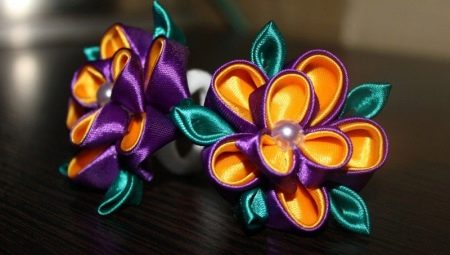If satin or silk ribbons are folded like origami, then glued and stitched, decorated with beads or rhinestones, you will get exquisite flowers, from which original women's accessories are formed. This peculiar Japanese technique is called kanzashi. In our article, we will talk about the art of creating ribbon flora and hold several workshops for beginners.
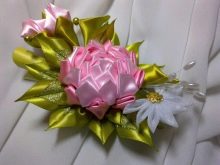
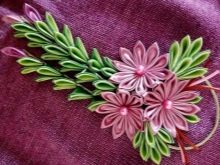
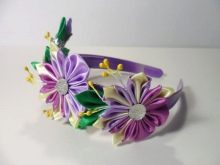
Basic manufacturing rules
Initially, amazing ribbon flowers were created by the hands of captivating geishas and were intended to decorate hairstyles. In addition, the Japanese believed in their mystical ability to drive away evil spirits.
Today, thanks to simple and inexpensive art, every woman can not only get an exclusive jewelry, but also become its author, invest her energy, presenting others with impeccable craftsmanship, her own special style and taste.
Nowadays, not only hair is decorated with ribbon flowers, they also decorate handbags, umbrellas, clothes, caskets, photo frames, holders for curtains and many other small things.
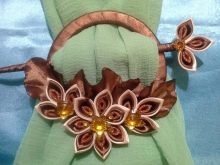

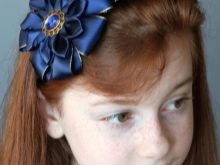
Kansashi technique has long gone beyond floristryIn addition to flowers from ribbons, animals, New Year's toys, snowflakes, satin Christmas trees and any other pleasant things are collected.
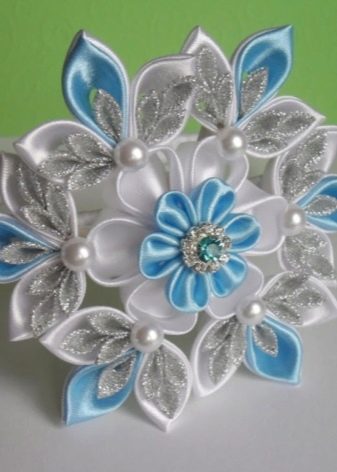
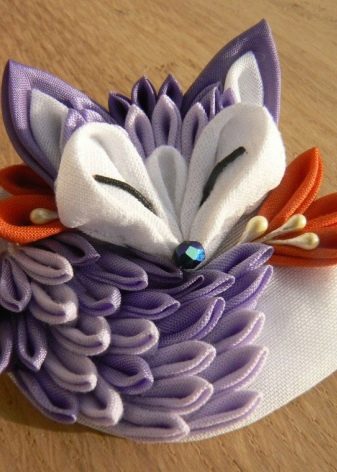
What to prepare?
Prepare miniature satin flowers and figures in advance. To work, you will need the following tools and materials:
- ribbons of different colors;
- needle with thread;
- scissors;
- candle or lighter;
- chalk for marking;
- transparent glue;
- tweezers;
- ruler.
Additional materials are selected as needed. Rhinestones, beads, lace, decorative cords or braid can come in handy. It is also necessary to take care of the basis on which future jewelry (box, barrette, postcard) is to be attached.
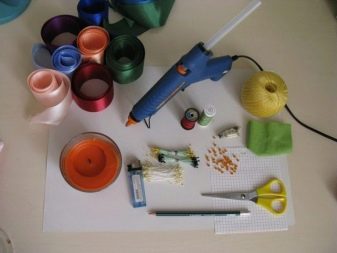
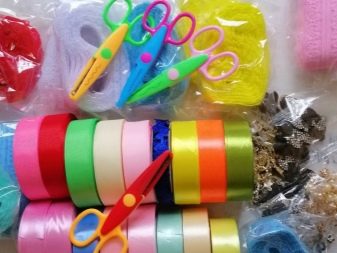
In ancient times, Japanese women chose satin and silk ribbons for their crafts. Today they recommend the use of their synthetic analogues. The edges of the products are scorched by the flame of a candle to prevent shedding. Natural materials burn well, but do not melt well, so modern craftswomen prefer synthetics.
Adhesive designed for fabrics can be purchased at a specialty store. It’s easy for them to work using a glue gun. To permanently fix the petals, some craftswomen use hair spray.
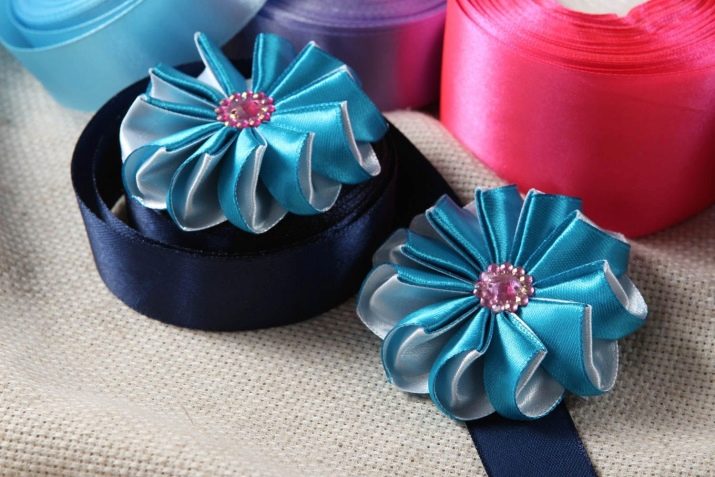
How to make flowers with different petals?
Professionals do not need instructions; they choose more complex techniques combined with weaving and origami elements. Masters of their craft try to use the most diverse elements in one composition in order to achieve volume and achieve the naturalness of the product.
Most often, folding ribbon crafts, they turn to floral elements - petals, leaves, buds. Beginners should master only two techniques for the execution of such products: with round and sharp petals. To create them, you need the simplest schemes, thinner and denser ribbons 5 cm wide.
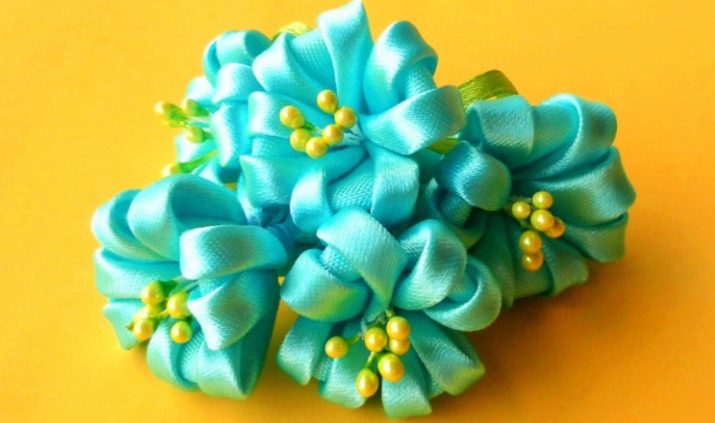
With round
Consider the phased creation of round petals, from which we will form a flower.
- Cut six squares from a wide ribbon.
- We fold them diagonally as paper products in such a way as to obtain isosceles triangles.
- We turn the workpiece right angle down and bring two sharp corners to it, collecting all three ends of the figure at one point. The resulting square is smaller, but more voluminous.
- We pull the lateral corners of the square to each other until they are in the center of the figure, clamp them with tweezers and carefully cut off the bottom edge of the workpiece (it is better to cut at an angle, it will look neater). A triangular shape with a rounded end already resembles a petal.
- We lower the lower section of the petal with the flame of a lighter and with our fingers still warm.
- To fix the product, the melted part is additionally glued.
- At the last stage, we lay out all the petals in a flower and sew or glue them together.
- We place a beautiful bead in the center of the product.
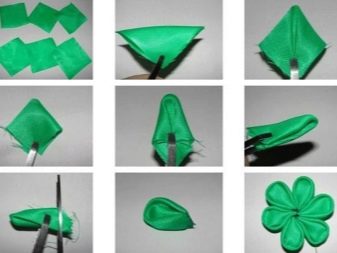
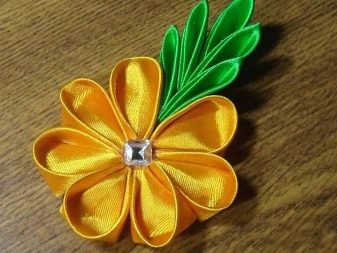
With sharp
Now we will learn how to make flowers with sharp petals. Phased process is as follows.
- Cut the squares from the tape, as in the previous version.
- We fold the squares diagonally, forming triangles.
- We bend the blanks again in half, combining sharp corners.
- And the third time we fold the triangle in half, making it very small, but voluminous.
- One of the sharp corners will become the upper part of the petal, for the second sharp corner we hold the workpiece. Then gently singe the lower part (base) and fix it with your fingers.
- From the blanks we form a flower, turning them to the core by seared corners. We decorate the center with a bead.
If such a flower is made of two contrasting squares folded together, a more effective product with a beautiful dark outline will be obtained.
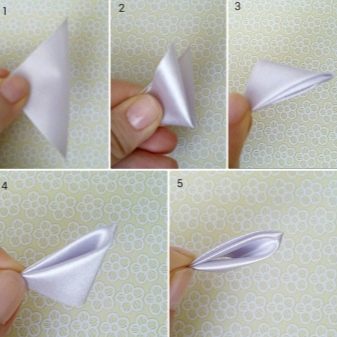

Other ideas
To fully master the technique of kanzashi, knowledge of the methods of manufacturing two types of base petals is not enough. We offer to study other techniques of popular needlework.
Bud formation
To create a magnificent rosebud, it is better to take a satin ribbon, it looks amazing on bends, imitating the gentle lines of the petals. Beginners should be warned that working with the atlas is difficult, it slides and bends harder, but the result is amazing.
- It is necessary to begin work with the deployment of a satin ironed ribbon on a solid surface.
- Next, slightly tuck the edge to the outside (along the entire length).
- Then gently twist the product into a small roll, the upper line of which remains bent.
- The lower even part is pulled together with threads (stitched), forming the base of the bud, and burned.
- The resulting blank is carefully opened from above, trying not to break the bend on the satin ribbon. With skillful movements, a twisted roll turns into a lush rose bud.
Having mastered the techniques for making sharp and round petals, you can begin to create more complex things. Spectacular figures are obtained from the holly details - a tree, a hedgehog, a crown, a swan and other cute products.
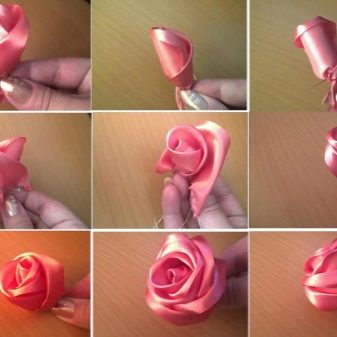
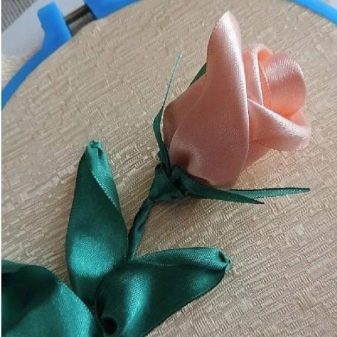
Butterfly making
We suggest that you familiarize yourself with another master class from which it becomes clear how easy it is to assemble a butterfly using the basic skills of making sharp and round petals. So, Let’s collect a beautiful insect from the fabric step by step.
- Cut into squares ribbons of different colors and sizes.
- From the received details we form the following types of petals: a pair of large light pointed blanks (petals) is made for the upper wings; then we form a pair of medium-sized rounded petals from a dark ribbon that are installed on large blanks of the upper wings (fixing can be done with glue or thread); another pair of miniature light sharp petals is placed in the center of the dark fragments of the upper wings. Next, we work with the lower wings - from light ribbon we make round petals, the size of which is similar to the parameters of the middle inserts of the upper wings; rounded blanks from dark fabric are made smaller and inserted into the prepared lower wings.
- Sew the finished butterfly or fix it with glue.
- We pull the lace tape from one longitudinal edge, getting a beautiful openwork flower, on which we install our butterfly. The color of the lace should match the dark wing inserts.
- Beads and beads will help to give a finished look to the product., from which we form the head and antennae of the insect, as well as decorate other butterfly elements.

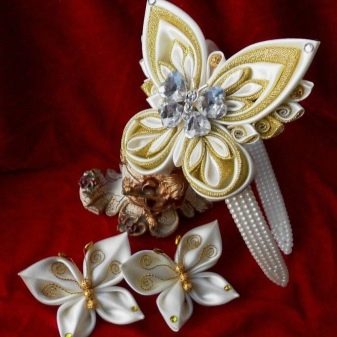
To make sure how beautiful the products are in the kanzashi technique, we suggest that you familiarize yourself with the new products belonging to the hands of talented craftswomen:
- a flower with pearls made of thick fabric;
- kanzashi style photo frames;
- yellow satin decorative pillows embroidered with ribbon flowers;
- wedding sets for the bride and groom, made using the kanzashi technique;
- grips and brushes for curtains;
- the bride’s bouquet, in which fresh flowers are replaced by ribbon analogues;
- designer knitted bag decorated in the style of kansashi.


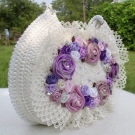


Recommendations
For beginners who do not yet have enough experience in the kanzashi technique, our recommendations may come in handy.
- Getting started on the product you need to pre-smooth the material, wrinkled ribbons will spoil the final appearance of the flower.
- For kanzashi figures it’s better to choose tight ribbons, they are stronger and more accurately keep their shape. It is only necessary to work with nylon and other delicate fabrics to create airy flowers. When choosing between satin and silk, we recommend silk for beginners, it is more convenient to bend and form petals.
- It’s better to start mastering the kanzashi technique with dark ribbons, they are less noticeable singeing defects. Having gained experience, you can proceed to work with light material.
- Instead of candles or lighters, craftswomen often use a soldering ironIt is not safe, but prevents contact with open fire.
- So that there are no traces of glue left on the product, it is necessary to choose transparent and thick compositions, for example, “Crystal Moment”.
- Over the fire blanks are held with tweezers, but it’s more convenient to form petals without it, using only your fingers.
- If you work with an open flame, it is better to bring the petal to its base, this will give it the opportunity to melt, and not burn.
- Creating a product from pointed petals, you need to ensure that all of them are wrapped in one direction, otherwise the perception of the "living" flower will be lost.

We hope that our simple recommendations will come in handy in work, will help beginners create beautiful and unique products.
Useful tips for beginners you can watch in the next video.
